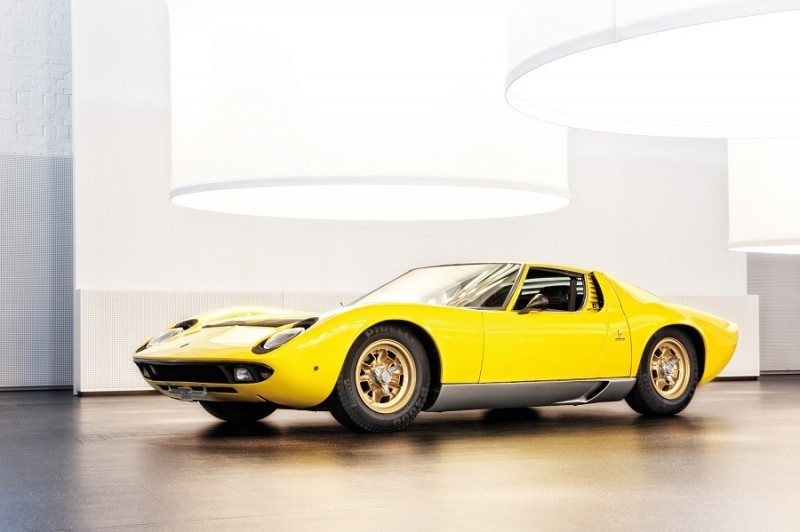
Lamborghini Miura - Every rivalry is a deep expression of respect
Let's start with a confession - Lamborghini is not necessarily my brand. The cars are often too angular, too brute for me. Nevertheless, Lamborghini has made a huge impact on the history of luxury sports cars. This article is dedicated to the Lamborghini Miura, with which its rapid rise actually began.
The Miura was built from 1966 to 1973 and introduced various traditions that we still recognise from Lamborghini today. Firstly, there is the name. Like most subsequent Lamborghinis, the Miura took its name from the context of bullfighting. Antonio Miura was a well-known breeder who bought a bull named Murciélago and thus founded a new breeding line. Secondly, there were to be different versions in the course of the series, which received increasingly powerful engines. The Miura was followed by the Miura S and finally the Miura SV. We still know this today from the Aventador and co.
These three basic models are joined by various one-off models. There is a roadster and a few Miura SVJ and SVR models, which are either based on the Jota test car or have a more powerful racing engine. If you add all these models together, there are probably just under 500 Miuras worldwide.
Technically and visually, the Miura went its own way right from the start. The radicalism that is still associated with the cars from Sant' Agata Bolognese today originated here. The chief designer Gian Paolo Dallara, who would later also cause a sensation in motor racing, developed a car together with his production manager Stanzani and test driver Wallace that was unique at the time in its radicalism. The Miura was only 1.05 metres high. This made the Miura designed by Marcello Gandini, who worked for Bertone, one of the flattest sports cars of its time. The Miura also broke sound barriers in terms of performance. Launched in 1971, the SV was the first production car to break the 300 km/h barrier.
What does the history of the Miura show us? In my view, it marks the beginning of developments, some of which continue to this day. Experts often regard the Miura as the first super sports car. The Miura was the first racing car for the road. Before that, the models offered by Ferrari and Co. were more clearly divided into different categories. There were the Grand Tourers for the "gentleman driver" and use on the road, as well as the classic racing cars, which were primarily intended for use on the racetrack. The Miura was intended to break this dichotomy. These racing cars for the road still exist today. Just think of the Aston Martin Valkyrie or the Mercedes-AMG One.
In recent years, the Lamborghini Miura has experienced a remarkable price development on the auction market. Initially, these cars were sold at prices equal to or slightly above their new value, but over time, especially from the 1980s and 1990s onwards, prices for well-preserved Miura models began to rise significantly. This trend was further fuelled by the growing recognition of classic sports cars as valuable collectors' items and investments.
In recent years, auction prices for Lamborghini Miuras have reached new heights, with particularly rare and well-preserved examples, such as the Miura SV versions, realising record sums. In 2016, a Miura SV could still be bought for USD 1.6 million. In 2021, a Miura SV was sold at RM Sothebys in Paris for USD 2.6 million and in 2023 in Scottsdale for USD 3.25 million.
The combination of its historical significance, ground-breaking design and rarity has obviously made the Miura highly sought after by collectors and enthusiasts.
I made my confession at the beginning - Lamborghini is not necessarily my brand. In any case, the relationship between Ferrari and Lamborghini is a fascinating story of rivalry and innovation that is deeply rooted in Italian automotive history. It began in the early 1960s when Ferruccio Lamborghini, originally a successful tractor manufacturer, expressed his dissatisfaction with his Ferrari. After a less than satisfactory response from Enzo Ferrari to his complaints, Lamborghini decided to set up his own company to compete with Ferrari.
This rivalry led to an era of intense competition, with both brands striving to develop the ultimate high-performance vehicle. While Ferrari was already established in motorsport in the 1950s and had built a reputation for high-performance, race-inspired sports cars, Lamborghini brought a new approach to the world of supercars with the Miura. "Never underestimate the power of an underdog. History is made by those who dare to believe that something inside them is stronger than circumstances" (Brad Meltzer, American author, born 1970).